-
Posts
4,900 -
Joined
-
Last visited
Content Type
Profiles
Forums
Store
Help Articles
Posts posted by Adam Balic
-
-
Interesting shrimp. We mostly only get frozen farmed tiger prawns, but occasionally you get these guys. I think that they are more interesting then the tiger prawns, so I would be interested in trying them fresh. Most likely this means a trip to India or SE-Asia.
-
Thanks everyone,
Still can't track down that bloody sandwich thing though.
As Behemoth mentioned upthread, I suspect nasturtiums are the filling, not just the flowers but more importantly, the leaves. They are a dead ringer for watercress in a blindfold taste test. Watercress butties have been around for awhile, right?
"Nasturtium" is the botanical genus name for water cress, but in English it is also the name for the un-related New World plant that is used here. The green seed posts were pickled to make faux capers at one point.
-
"00" refers more to the level of refinement of the flour then the protein content. "00" flour has a very fine texture, low ash content and a dry gluten content that is a minimum of 7%. The last bit is important as it is a minimum figure and while most people equate % protein of the flour with gluten content, the dry gluten content is slightly different thing. So while by definition "00" flour as a minimum protein content, but this doesn't mean that all "00" flour have the same protein content or that the protein conten is a direct correlation with the gluten content.
So you can see from This Italian Mill that there is a huge range in the types of "00" flour produced. The same site has specific pizza flour and it helpfully mentions the gluten and protein content of the flour, so you should be able to recreat something similar.
-
Thanks very much for this advise, much appreciated.
A common issue I have with all my cooking as that I am doing it from books, without any actual examples on how the dish is actually fisnished, no matter how good the book, there is a lot of guess work from me. I'm not an instinctive cook, so much trial and error is involved.
The sauce will be put though a tamis next time. The texture of the finished paste was buttery, but with some granularity. I think that this was the sesame seeds. Really makes me appreciate how skilled people are when using a cormal to produce the paste.
What is the final texture of the sauce ment to be like? Like single cream?
I added the stock at the end (bit by bit), I will follow your advise in the future. The stock I used contained carrot, celery and white onion. I think that this was also an error.
Chocolate - I have not ready acccess to the Mexican type here (mail order maybe). My understanding is that it contains almonds and spice etc. Would not the spice and almonds added seperately to the mole paste make up for his lack? I guess that all the cooking steps could make a diference to the spice flavour profile, so maybe I should add some more spice in at the final moment.
-
Although it has has improved greatly in the last five years or so, sometime Edinburgh can be frustrating from a food point of view.
I've actually seen cloudberries growing in Scotland a few times, so you could pick your own.
Thanks for the info about the flowering quince, I have wanted to know how they are used for a while.
-
Yes, I think that this was an issue. Although it wasn't a very rich stock, it certainly wasn't light.
-
One thing strikes me as a bit odd - they keep going on about seasonality - lots of asparagus about for example, but what is in season for the competition won't be for the actual meal will it?
As hotpot appeared on a summer menu, I think that we can forget about any present connection of the food at what will eventually be served. Or at least I hope so.
-
It may be a question of nomeclature, but anything that is altered by microbiol action is fermented, it doesn't have to produce alcohol.
I have also read that whey was stored in oak barrels in Iceland for use as a beverage (or to put out fires) until recently. Have you heard of this? In Scotland it is called Blaand in Shetland.
-
That's very interesting Nanna. The dairy product I was thinking of is Skyr, have you eaten this? Similar products were once made in Scotland.
-
I made chicken Mole Puebla Style recently, here are some observations. Recipe largely based on that of Elisabeth Lambert-Ortiz, but also from other sources I have read here and there
Chiles left to right: Ancho (6), Pastilla (4), Mulato (4).
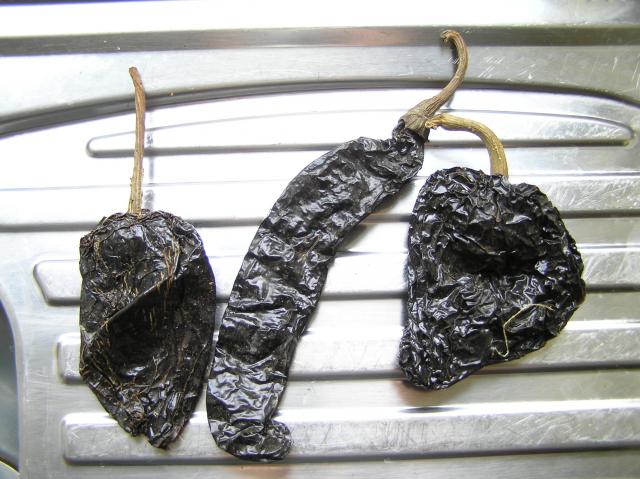
These are fried in lard (briefly), after which they puff up and turn a nice reddish colour.
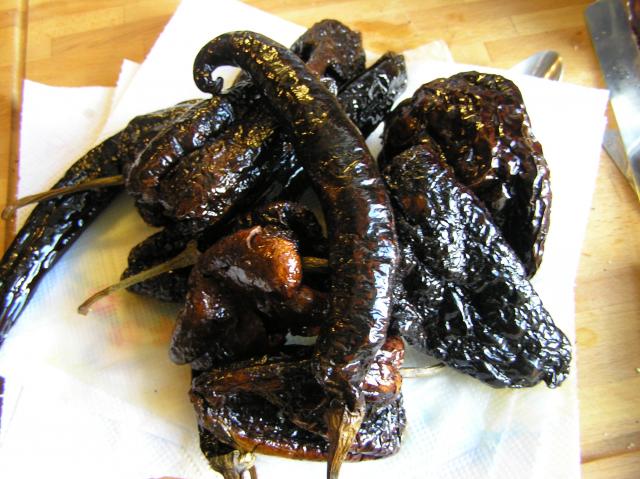
These are torn up and left to soak for half an hour or so.
Meanwhile, onions and garlic are browned. Some recipes don't do this step, but I think that if you don't do it, it takes too long to cook the rawness out of the onion later and you get a extra layer of flavour from the brown bits.
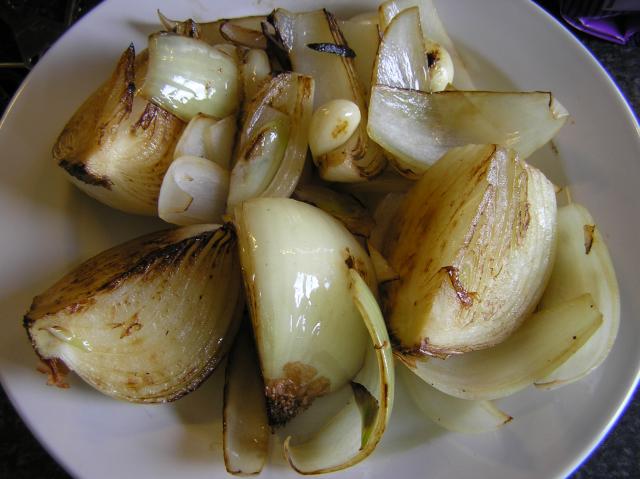
The nuts/seeds I am using are almonds, seasame and pecans. The later aren't traditional as far as I know, but I like them. Only lightly toasted as there are enough earthy background elements already and in this Mole I'm not adding many lighter fruit elements (tomatilla, plantain, apple etc)
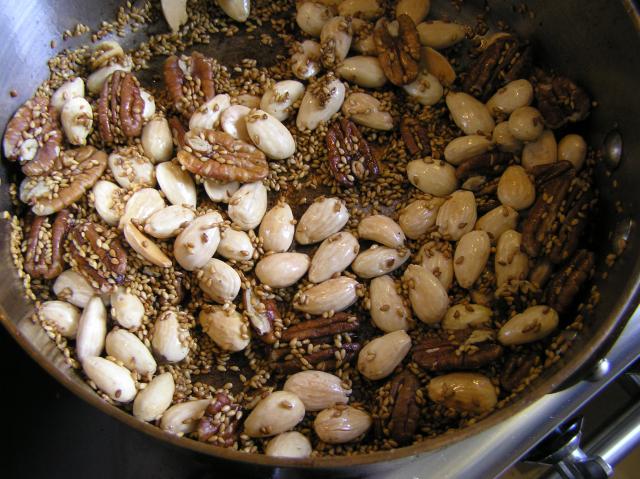
Spices et al.: Cinnamon (not cassia), anise verde (not fennel), cloves, seasame, pepper, corinader and chocolate. I can't get Mexican chocolate here, so regular dark it is. The corinader is really important IMO as it's flavour is very bright and isn't dominated by the other more earthy elements.
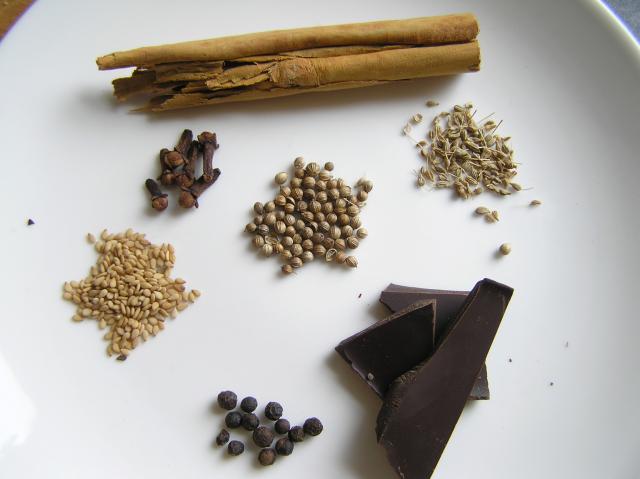
Right. The onions and chilies are blended with tomatoes, then the nuts, spices, raisins and some green corinader are added and blended until the motor started to burn out.
At this point you have a basic sauce. The next step is to fry it in lard and finally, you add the chocolate. The frying step is really important as although there isn't a huge difference in the appearance of the Mole, the flavour is very raw at this stage. Frying mellows the flavours (and removes the raw tomato taste) and removes the bitterness. Chocolate adds no distinct flavour really, but changes the colour slightly and adds another element of earthy background flavour.
Left to right: Raw, fried, after addition of chocolate.

After this I cooked the chicken and made a stock from the bodies and bones. Mole paste was diluted with the stock and used to warm through the chicken. Up until this point I was very happy with the flavour of the mole, but on addition to the stock the flavours became quite leaden. Not sure what happened here, it was as if the spice flavours disapeared - maybe the stock I made was wrong wfor this dish or maybe I got the acid level wrong. Anyway, an OK meal, not a great one.
-
Doesn't seem to be the case for Hong Kong and India.
-
I don't think that there is much doubt that there is poor food out there in the world. But why bother with yet another article along the lines of "Look at that funny food that Johnny foreiger eats, isn't it bad!".
Even if food is preceived "bad", then it can at least be interesting. Personally, raw puffin, fermented shark live and various fermemnted dairy products in Iceland sound pretty vile, but I would still be interested in reading a decently written article on them.
-
Soft-shelled crab isn't a species as such, it is the crab immediately after the moult when the new carapace hasn't hardened. Obviously, in a given location the actualy species will be restricted to what is found locally.
In Europe, Venice is famous for it's small soft shelled crab, whereas in the USA they are Blue crab. In the UK you can buy them frozen, but I have seen on Rick Stein show where he gets some local sof shelled crabs in Cornwall.
I have to agree that they are a strange choice for a 'British' menu.
-
Tastes like cucumber, which is why cucumber replaces it in a Pims and lemonade.
-
I thnk that the regional food concept can be dropped, as there has been little evidence of it throughout the series.
Sure, soft-shelled crab isn't a particularly British ingredient, but quite a few of the dishes are more international then British. If you wanted to stretch a point I guess you could say that it was representative of the 'regional' cooking of London?

-
Lazy article. Bashing relatively poorly know cuisines seems to be a cyclic thing in the UK food press. One such article every few years or so.
I will be very happy when the present vibe of the age (dominated by cynical, satirical humour written by self-absorbed 30-40 somethings) passes and some articles with some real meat get published.
This is a link to my week long stay in Lihuania and some comments about the food. As you will be the food is quite diverse and you could write an interesting article on it. Since tourism is dramitically increasing in the region, you would think that this would be an obvious thing to do.
Yes there are some stodgy dishes (baked slabs of mashed potato stand out in my mind), but that hardly defines the cuisine. How difficult would it be to not make a cheap shot for a change and write something substantive?
-
Interesting isn't it. Take the troffie that I posted about earlier. These dried troffie have very little to do with the 'traditional' dumpling like trofiie. Yet, as the tradional form is a pain in the arse to make and cooking habits have changed, the dried form will become the recognised authentic product.
-
Click. Often labeled as limoncello, there are huge amounts of it sold in the Cinque Terra. If you are lucky you can also get Cedrocello.
Adam, nice to see the Ligurians are using their traditional sense for commerce. Nonetheless, I would bet that they haven't been producing the stuff for more than 20-25 years. Before the 80s limoncello/limoncino was known only in Campania and in particular produced in the area between Neapolitan Islands (Capri, Ischia and Procida) and the Amalfi coast. I am pretty sure of that because my family has some very close Ligurian friends and we used to bring them limoncello whenever we visited a few years back because they could not find the stuff there.
About mid 80s, Limoncello's fame boomed and it is now produced everywhere, from Sicily to... Liguria
 . Can't really understand why to be honest, the stuff is way too sweet for my taste.
. Can't really understand why to be honest, the stuff is way too sweet for my taste.Oh, yes I quite agree. But how long does it take to make it a local product, if not regional?
-
What's un-British about Anglo-Indian cooking?
For that matter does any body have a useful definition of British cooking? The idea that because an ingredient is sourced from the UK, doesn't make a dish British IMO.
-
This BBC site has suggestions. In the East bannana flowers and vaious legume flowers are eaten, a blue flower used for its dye and cockscomb is used in Kashmiri cusisne for its red dye.
In the UK marigold petals were used to dye butter/cheese (can't remember which).
Obviously squash blossoms.
Cloves are flower buds.
Some people eat day lilies.
Flowers like rape, rocket and fennel are increasingly being used in poncy cooking.
-
Citrus medica. Like a really big thick skinned lemon, with little juice. Peel is often candied and refered to as 'candied citron', as this is the French name. Doesn't taste much like a lemon though.
-
Like limoncello, but made from [green] cedro.
-
Click. Often labeled as limoncello, there are huge amounts of it sold in the Cinque Terra. If you are lucky you can also get Cedrocello.
-
To my taste, the color and texture looks just right. If it's not "authentic", I don't want to know about it!

Sure it tasted fine, but I guess that point is that although this is a greek dish, it could just conceivably be from some hypothetical SW-French village and called cassoulet?
Rabelais - have found mention of a bean and bacon dish and olla podrida, but nothing like cassoulet (yet).



Moles and their chilies
in Mexico: Cooking & Baking
Posted
Oops, my error.